Analysis of Contemporary Economics: Supply, Demand, and Theories
VerifiedAdded on 2023/01/12
|14
|2885
|90
Report
AI Summary
This report provides a comprehensive analysis of contemporary economic concepts, focusing on microeconomic principles and their application in the retail sector. The report begins by demonstrating the laws of supply and demand, examining the factors that influence the demand and supply curves, ...
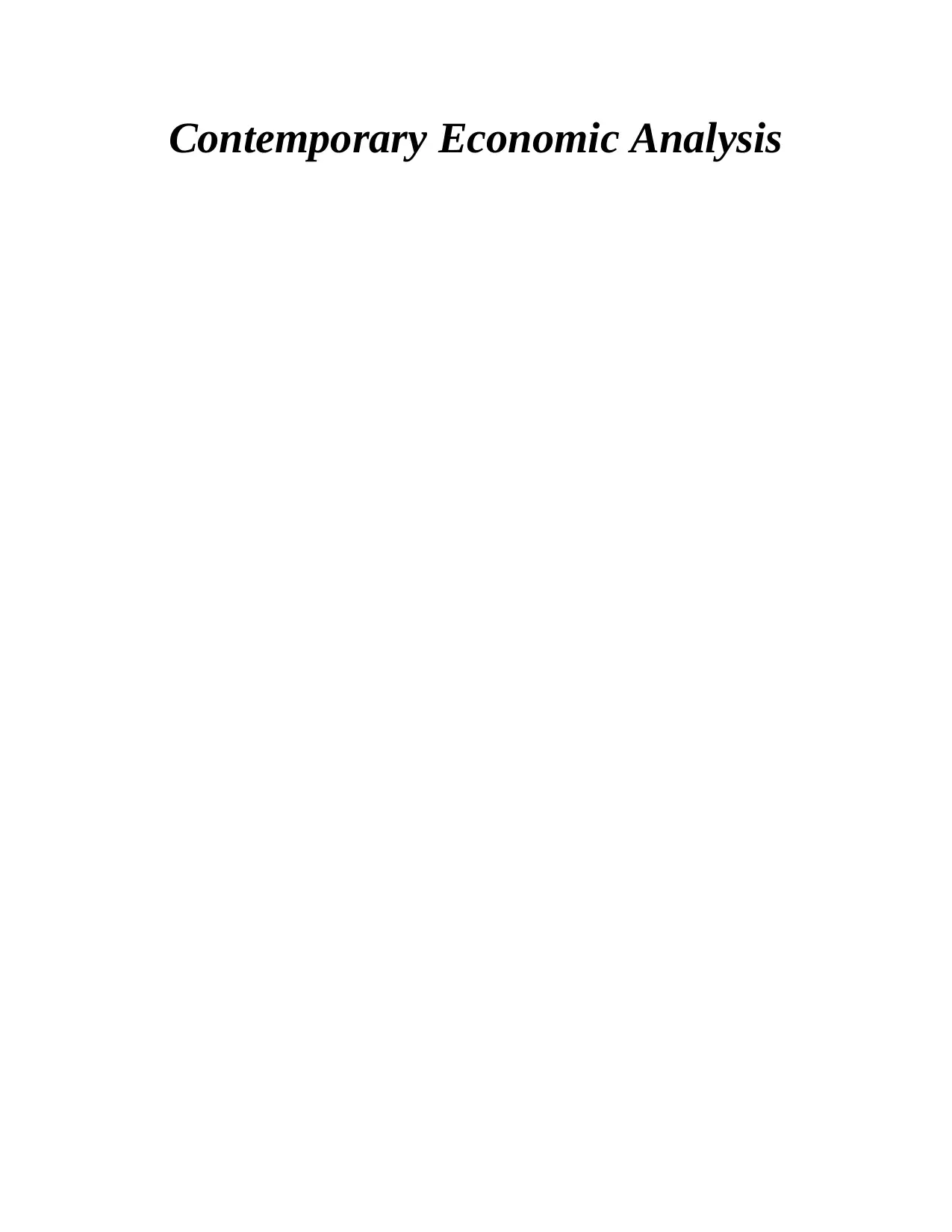
Contemporary Economic Analysis
Paraphrase This Document
Need a fresh take? Get an instant paraphrase of this document with our AI Paraphraser
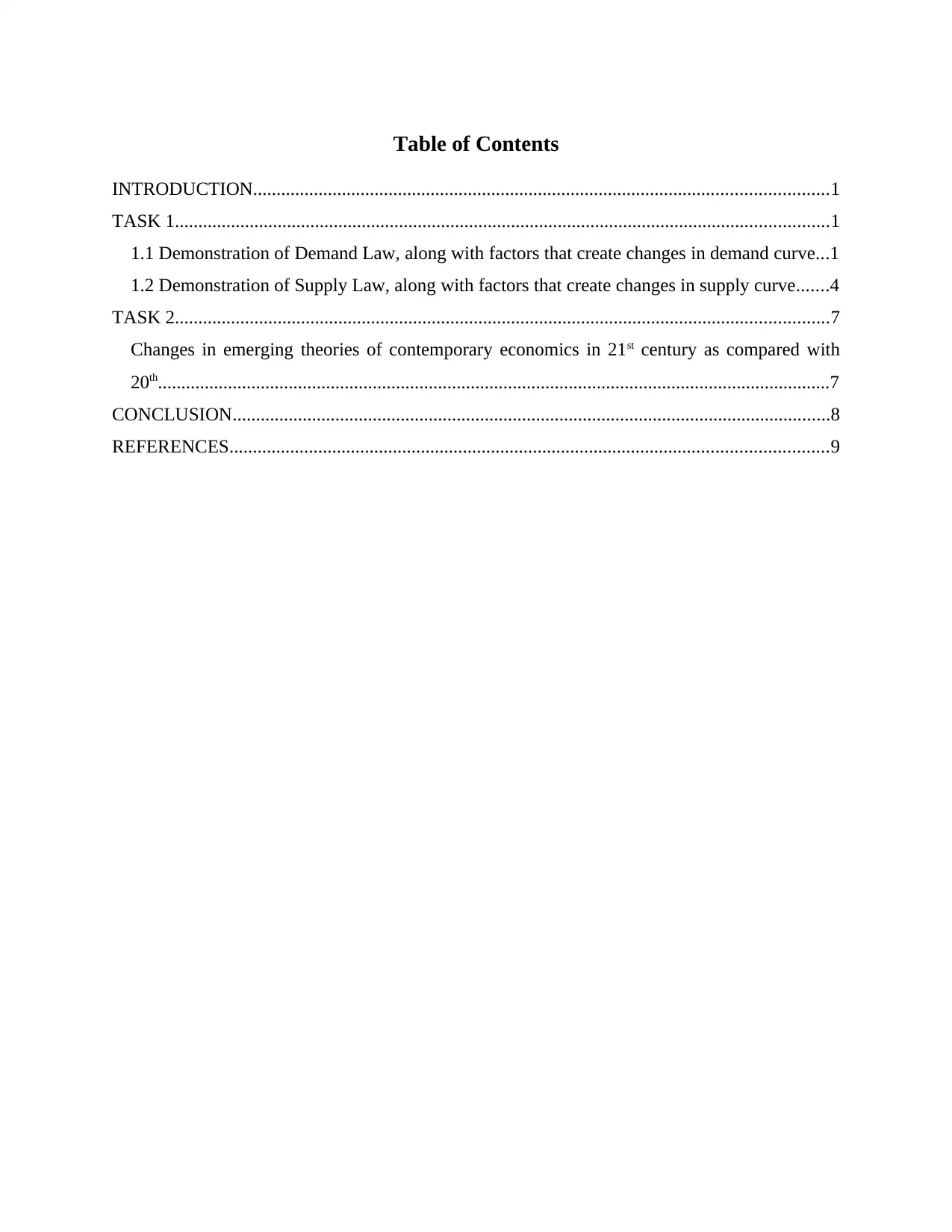
Table of Contents
INTRODUCTION...........................................................................................................................1
TASK 1............................................................................................................................................1
1.1 Demonstration of Demand Law, along with factors that create changes in demand curve...1
1.2 Demonstration of Supply Law, along with factors that create changes in supply curve.......4
TASK 2............................................................................................................................................7
Changes in emerging theories of contemporary economics in 21st century as compared with
20th................................................................................................................................................7
CONCLUSION................................................................................................................................8
REFERENCES................................................................................................................................9
INTRODUCTION...........................................................................................................................1
TASK 1............................................................................................................................................1
1.1 Demonstration of Demand Law, along with factors that create changes in demand curve...1
1.2 Demonstration of Supply Law, along with factors that create changes in supply curve.......4
TASK 2............................................................................................................................................7
Changes in emerging theories of contemporary economics in 21st century as compared with
20th................................................................................................................................................7
CONCLUSION................................................................................................................................8
REFERENCES................................................................................................................................9

⊘ This is a preview!⊘
Do you want full access?
Subscribe today to unlock all pages.

Trusted by 1+ million students worldwide
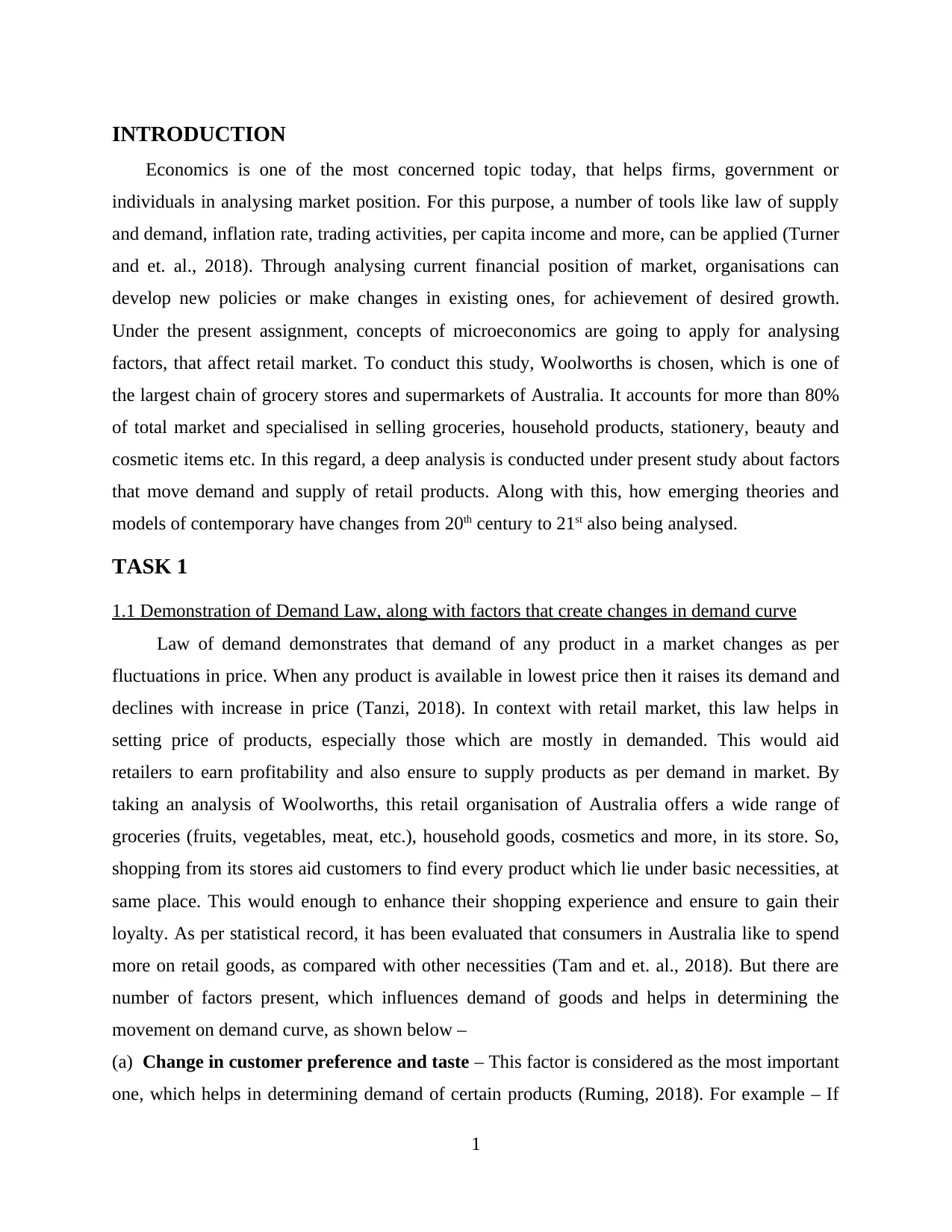
INTRODUCTION
Economics is one of the most concerned topic today, that helps firms, government or
individuals in analysing market position. For this purpose, a number of tools like law of supply
and demand, inflation rate, trading activities, per capita income and more, can be applied (Turner
and et. al., 2018). Through analysing current financial position of market, organisations can
develop new policies or make changes in existing ones, for achievement of desired growth.
Under the present assignment, concepts of microeconomics are going to apply for analysing
factors, that affect retail market. To conduct this study, Woolworths is chosen, which is one of
the largest chain of grocery stores and supermarkets of Australia. It accounts for more than 80%
of total market and specialised in selling groceries, household products, stationery, beauty and
cosmetic items etc. In this regard, a deep analysis is conducted under present study about factors
that move demand and supply of retail products. Along with this, how emerging theories and
models of contemporary have changes from 20th century to 21st also being analysed.
TASK 1
1.1 Demonstration of Demand Law, along with factors that create changes in demand curve
Law of demand demonstrates that demand of any product in a market changes as per
fluctuations in price. When any product is available in lowest price then it raises its demand and
declines with increase in price (Tanzi, 2018). In context with retail market, this law helps in
setting price of products, especially those which are mostly in demanded. This would aid
retailers to earn profitability and also ensure to supply products as per demand in market. By
taking an analysis of Woolworths, this retail organisation of Australia offers a wide range of
groceries (fruits, vegetables, meat, etc.), household goods, cosmetics and more, in its store. So,
shopping from its stores aid customers to find every product which lie under basic necessities, at
same place. This would enough to enhance their shopping experience and ensure to gain their
loyalty. As per statistical record, it has been evaluated that consumers in Australia like to spend
more on retail goods, as compared with other necessities (Tam and et. al., 2018). But there are
number of factors present, which influences demand of goods and helps in determining the
movement on demand curve, as shown below –
(a) Change in customer preference and taste – This factor is considered as the most important
one, which helps in determining demand of certain products (Ruming, 2018). For example – If
1
Economics is one of the most concerned topic today, that helps firms, government or
individuals in analysing market position. For this purpose, a number of tools like law of supply
and demand, inflation rate, trading activities, per capita income and more, can be applied (Turner
and et. al., 2018). Through analysing current financial position of market, organisations can
develop new policies or make changes in existing ones, for achievement of desired growth.
Under the present assignment, concepts of microeconomics are going to apply for analysing
factors, that affect retail market. To conduct this study, Woolworths is chosen, which is one of
the largest chain of grocery stores and supermarkets of Australia. It accounts for more than 80%
of total market and specialised in selling groceries, household products, stationery, beauty and
cosmetic items etc. In this regard, a deep analysis is conducted under present study about factors
that move demand and supply of retail products. Along with this, how emerging theories and
models of contemporary have changes from 20th century to 21st also being analysed.
TASK 1
1.1 Demonstration of Demand Law, along with factors that create changes in demand curve
Law of demand demonstrates that demand of any product in a market changes as per
fluctuations in price. When any product is available in lowest price then it raises its demand and
declines with increase in price (Tanzi, 2018). In context with retail market, this law helps in
setting price of products, especially those which are mostly in demanded. This would aid
retailers to earn profitability and also ensure to supply products as per demand in market. By
taking an analysis of Woolworths, this retail organisation of Australia offers a wide range of
groceries (fruits, vegetables, meat, etc.), household goods, cosmetics and more, in its store. So,
shopping from its stores aid customers to find every product which lie under basic necessities, at
same place. This would enough to enhance their shopping experience and ensure to gain their
loyalty. As per statistical record, it has been evaluated that consumers in Australia like to spend
more on retail goods, as compared with other necessities (Tam and et. al., 2018). But there are
number of factors present, which influences demand of goods and helps in determining the
movement on demand curve, as shown below –
(a) Change in customer preference and taste – This factor is considered as the most important
one, which helps in determining demand of certain products (Ruming, 2018). For example – If
1
Paraphrase This Document
Need a fresh take? Get an instant paraphrase of this document with our AI Paraphraser
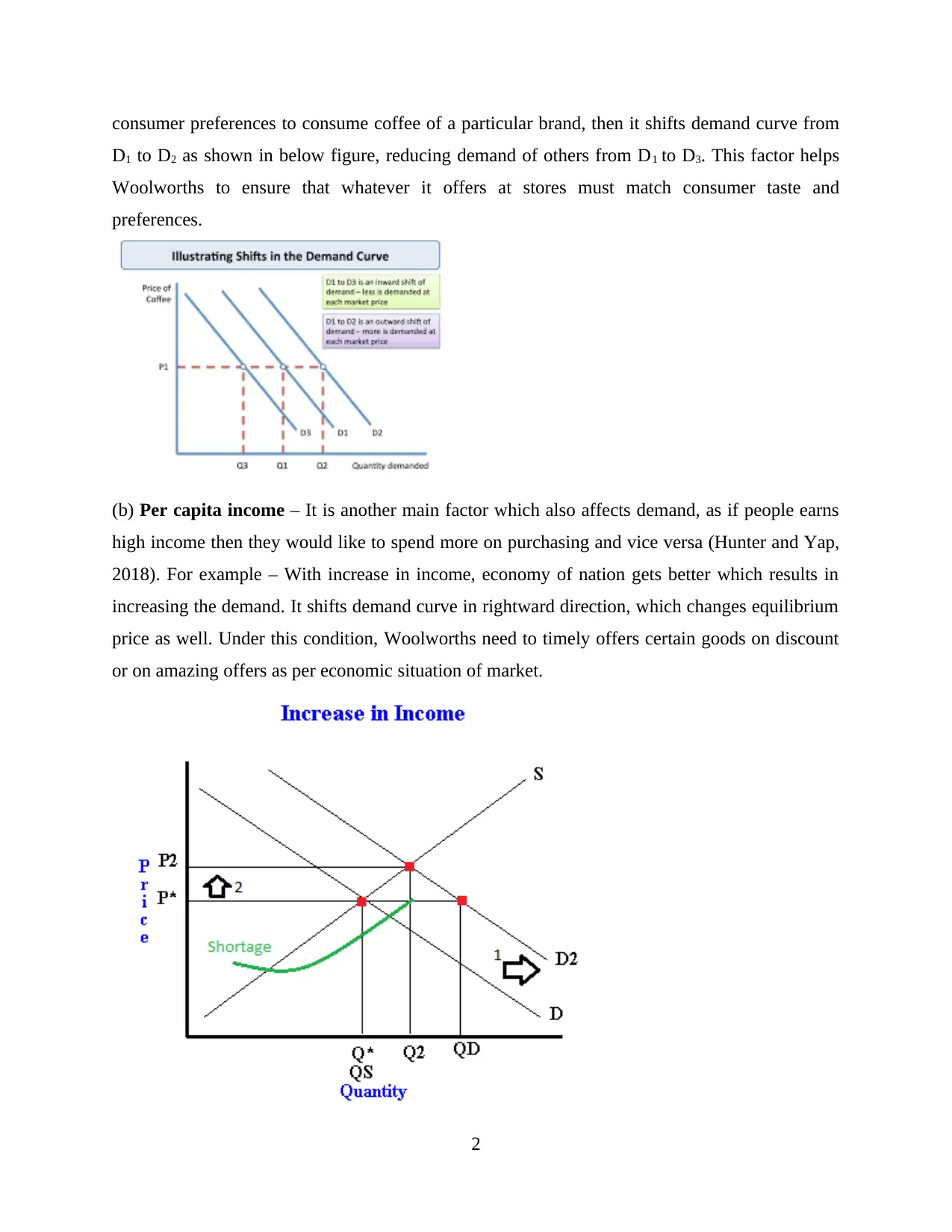
consumer preferences to consume coffee of a particular brand, then it shifts demand curve from
D1 to D2 as shown in below figure, reducing demand of others from D1 to D3. This factor helps
Woolworths to ensure that whatever it offers at stores must match consumer taste and
preferences.
(b) Per capita income – It is another main factor which also affects demand, as if people earns
high income then they would like to spend more on purchasing and vice versa (Hunter and Yap,
2018). For example – With increase in income, economy of nation gets better which results in
increasing the demand. It shifts demand curve in rightward direction, which changes equilibrium
price as well. Under this condition, Woolworths need to timely offers certain goods on discount
or on amazing offers as per economic situation of market.
2
D1 to D2 as shown in below figure, reducing demand of others from D1 to D3. This factor helps
Woolworths to ensure that whatever it offers at stores must match consumer taste and
preferences.
(b) Per capita income – It is another main factor which also affects demand, as if people earns
high income then they would like to spend more on purchasing and vice versa (Hunter and Yap,
2018). For example – With increase in income, economy of nation gets better which results in
increasing the demand. It shifts demand curve in rightward direction, which changes equilibrium
price as well. Under this condition, Woolworths need to timely offers certain goods on discount
or on amazing offers as per economic situation of market.
2
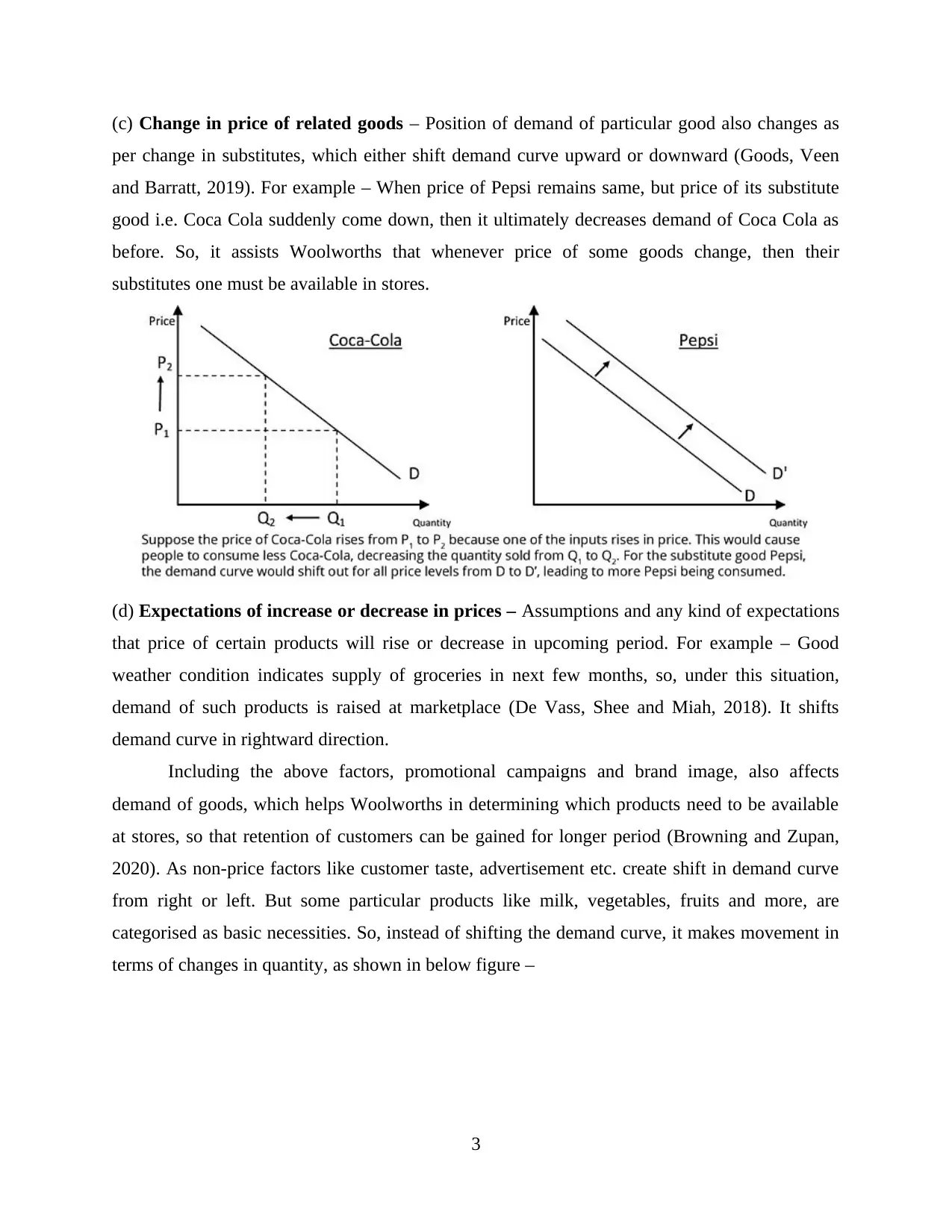
(c) Change in price of related goods – Position of demand of particular good also changes as
per change in substitutes, which either shift demand curve upward or downward (Goods, Veen
and Barratt, 2019). For example – When price of Pepsi remains same, but price of its substitute
good i.e. Coca Cola suddenly come down, then it ultimately decreases demand of Coca Cola as
before. So, it assists Woolworths that whenever price of some goods change, then their
substitutes one must be available in stores.
(d) Expectations of increase or decrease in prices – Assumptions and any kind of expectations
that price of certain products will rise or decrease in upcoming period. For example – Good
weather condition indicates supply of groceries in next few months, so, under this situation,
demand of such products is raised at marketplace (De Vass, Shee and Miah, 2018). It shifts
demand curve in rightward direction.
Including the above factors, promotional campaigns and brand image, also affects
demand of goods, which helps Woolworths in determining which products need to be available
at stores, so that retention of customers can be gained for longer period (Browning and Zupan,
2020). As non-price factors like customer taste, advertisement etc. create shift in demand curve
from right or left. But some particular products like milk, vegetables, fruits and more, are
categorised as basic necessities. So, instead of shifting the demand curve, it makes movement in
terms of changes in quantity, as shown in below figure –
3
per change in substitutes, which either shift demand curve upward or downward (Goods, Veen
and Barratt, 2019). For example – When price of Pepsi remains same, but price of its substitute
good i.e. Coca Cola suddenly come down, then it ultimately decreases demand of Coca Cola as
before. So, it assists Woolworths that whenever price of some goods change, then their
substitutes one must be available in stores.
(d) Expectations of increase or decrease in prices – Assumptions and any kind of expectations
that price of certain products will rise or decrease in upcoming period. For example – Good
weather condition indicates supply of groceries in next few months, so, under this situation,
demand of such products is raised at marketplace (De Vass, Shee and Miah, 2018). It shifts
demand curve in rightward direction.
Including the above factors, promotional campaigns and brand image, also affects
demand of goods, which helps Woolworths in determining which products need to be available
at stores, so that retention of customers can be gained for longer period (Browning and Zupan,
2020). As non-price factors like customer taste, advertisement etc. create shift in demand curve
from right or left. But some particular products like milk, vegetables, fruits and more, are
categorised as basic necessities. So, instead of shifting the demand curve, it makes movement in
terms of changes in quantity, as shown in below figure –
3
⊘ This is a preview!⊘
Do you want full access?
Subscribe today to unlock all pages.

Trusted by 1+ million students worldwide
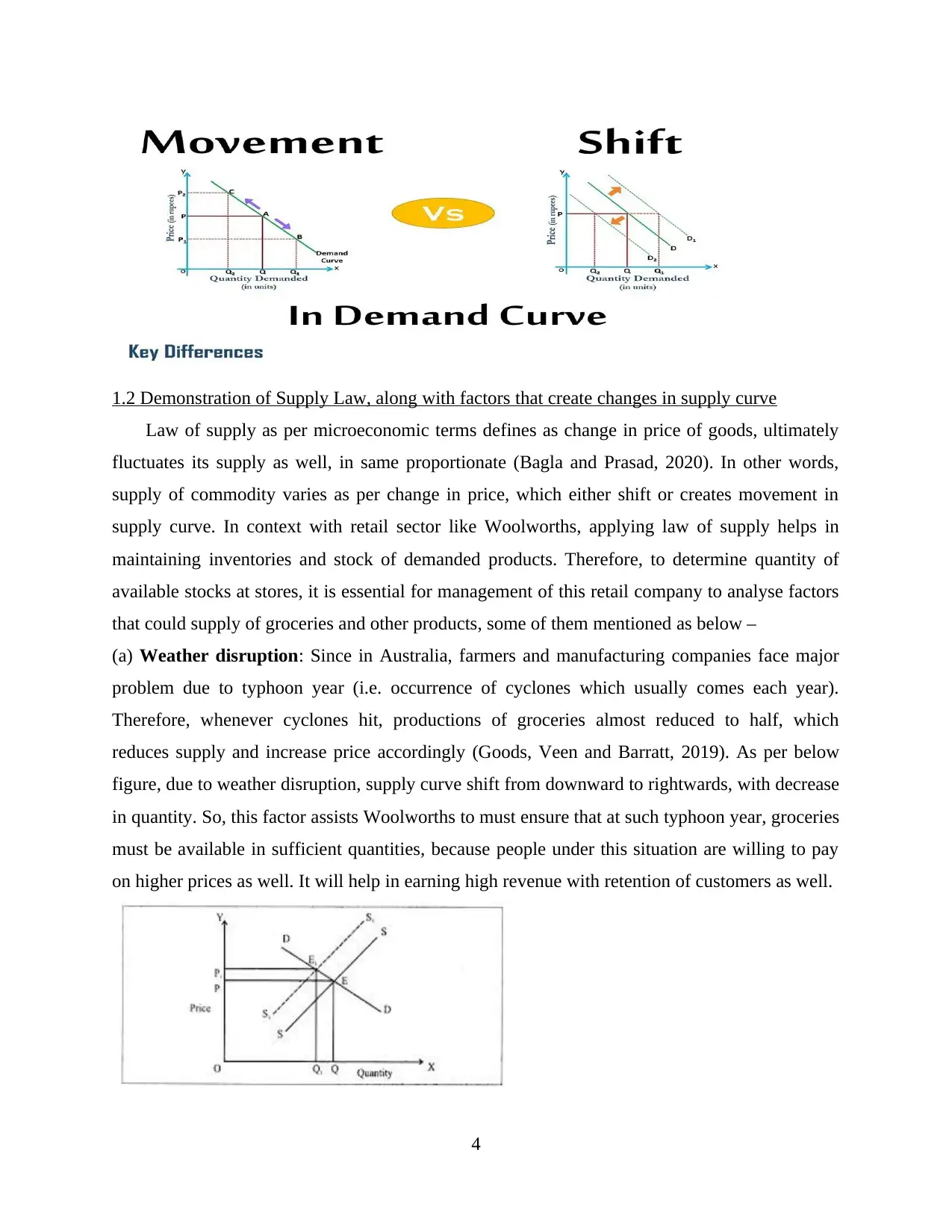
1.2 Demonstration of Supply Law, along with factors that create changes in supply curve
Law of supply as per microeconomic terms defines as change in price of goods, ultimately
fluctuates its supply as well, in same proportionate (Bagla and Prasad, 2020). In other words,
supply of commodity varies as per change in price, which either shift or creates movement in
supply curve. In context with retail sector like Woolworths, applying law of supply helps in
maintaining inventories and stock of demanded products. Therefore, to determine quantity of
available stocks at stores, it is essential for management of this retail company to analyse factors
that could supply of groceries and other products, some of them mentioned as below –
(a) Weather disruption: Since in Australia, farmers and manufacturing companies face major
problem due to typhoon year (i.e. occurrence of cyclones which usually comes each year).
Therefore, whenever cyclones hit, productions of groceries almost reduced to half, which
reduces supply and increase price accordingly (Goods, Veen and Barratt, 2019). As per below
figure, due to weather disruption, supply curve shift from downward to rightwards, with decrease
in quantity. So, this factor assists Woolworths to must ensure that at such typhoon year, groceries
must be available in sufficient quantities, because people under this situation are willing to pay
on higher prices as well. It will help in earning high revenue with retention of customers as well.
4
Law of supply as per microeconomic terms defines as change in price of goods, ultimately
fluctuates its supply as well, in same proportionate (Bagla and Prasad, 2020). In other words,
supply of commodity varies as per change in price, which either shift or creates movement in
supply curve. In context with retail sector like Woolworths, applying law of supply helps in
maintaining inventories and stock of demanded products. Therefore, to determine quantity of
available stocks at stores, it is essential for management of this retail company to analyse factors
that could supply of groceries and other products, some of them mentioned as below –
(a) Weather disruption: Since in Australia, farmers and manufacturing companies face major
problem due to typhoon year (i.e. occurrence of cyclones which usually comes each year).
Therefore, whenever cyclones hit, productions of groceries almost reduced to half, which
reduces supply and increase price accordingly (Goods, Veen and Barratt, 2019). As per below
figure, due to weather disruption, supply curve shift from downward to rightwards, with decrease
in quantity. So, this factor assists Woolworths to must ensure that at such typhoon year, groceries
must be available in sufficient quantities, because people under this situation are willing to pay
on higher prices as well. It will help in earning high revenue with retention of customers as well.
4
Paraphrase This Document
Need a fresh take? Get an instant paraphrase of this document with our AI Paraphraser

(b) Trade restrictions: This factor also impacts on supply of products at marketplace, because in
case of shortage of certain goods, a country imports the same from foreign to meet customer’s
demand. But due to trade restrictions among nations, highly increase shortage in supply of
goods. In context with Australia, to overcome from such factors they import goods on high price,
which increases market price as well (Tanzi, 2018). The given figure, shows imposed tariff rate
on goods due to shortage in domestic ones.
(c) Inflation and interest rate: Inflation or deflation period of economy also impact on
aggregate supply of goods. As shown in below figure, increase in national income shows
inflation period which increases aggregate supply as well. Therefore, this factor helps
Woolworths in setting price of products as per market situation.
5
case of shortage of certain goods, a country imports the same from foreign to meet customer’s
demand. But due to trade restrictions among nations, highly increase shortage in supply of
goods. In context with Australia, to overcome from such factors they import goods on high price,
which increases market price as well (Tanzi, 2018). The given figure, shows imposed tariff rate
on goods due to shortage in domestic ones.
(c) Inflation and interest rate: Inflation or deflation period of economy also impact on
aggregate supply of goods. As shown in below figure, increase in national income shows
inflation period which increases aggregate supply as well. Therefore, this factor helps
Woolworths in setting price of products as per market situation.
5
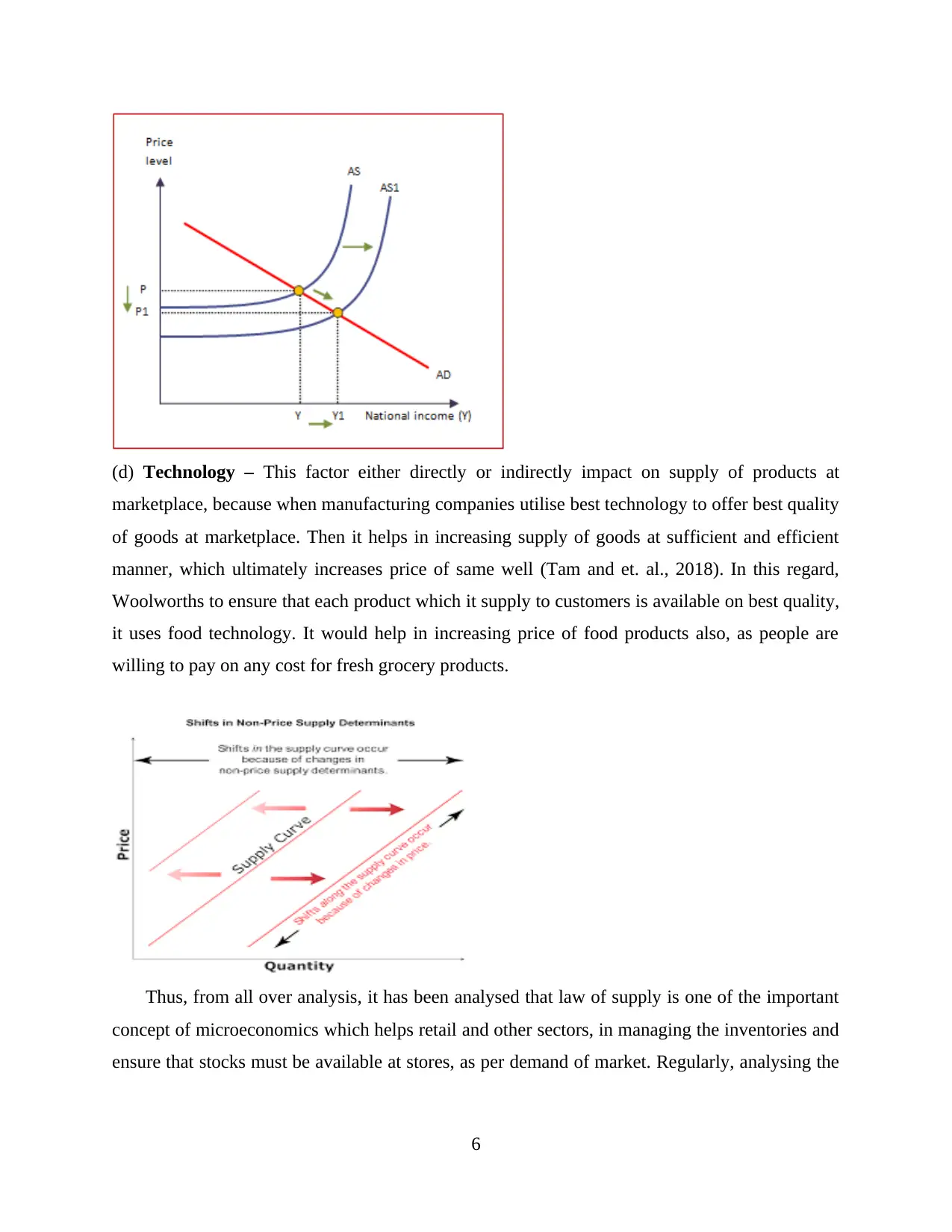
(d) Technology – This factor either directly or indirectly impact on supply of products at
marketplace, because when manufacturing companies utilise best technology to offer best quality
of goods at marketplace. Then it helps in increasing supply of goods at sufficient and efficient
manner, which ultimately increases price of same well (Tam and et. al., 2018). In this regard,
Woolworths to ensure that each product which it supply to customers is available on best quality,
it uses food technology. It would help in increasing price of food products also, as people are
willing to pay on any cost for fresh grocery products.
Thus, from all over analysis, it has been analysed that law of supply is one of the important
concept of microeconomics which helps retail and other sectors, in managing the inventories and
ensure that stocks must be available at stores, as per demand of market. Regularly, analysing the
6
marketplace, because when manufacturing companies utilise best technology to offer best quality
of goods at marketplace. Then it helps in increasing supply of goods at sufficient and efficient
manner, which ultimately increases price of same well (Tam and et. al., 2018). In this regard,
Woolworths to ensure that each product which it supply to customers is available on best quality,
it uses food technology. It would help in increasing price of food products also, as people are
willing to pay on any cost for fresh grocery products.
Thus, from all over analysis, it has been analysed that law of supply is one of the important
concept of microeconomics which helps retail and other sectors, in managing the inventories and
ensure that stocks must be available at stores, as per demand of market. Regularly, analysing the
6
⊘ This is a preview!⊘
Do you want full access?
Subscribe today to unlock all pages.

Trusted by 1+ million students worldwide
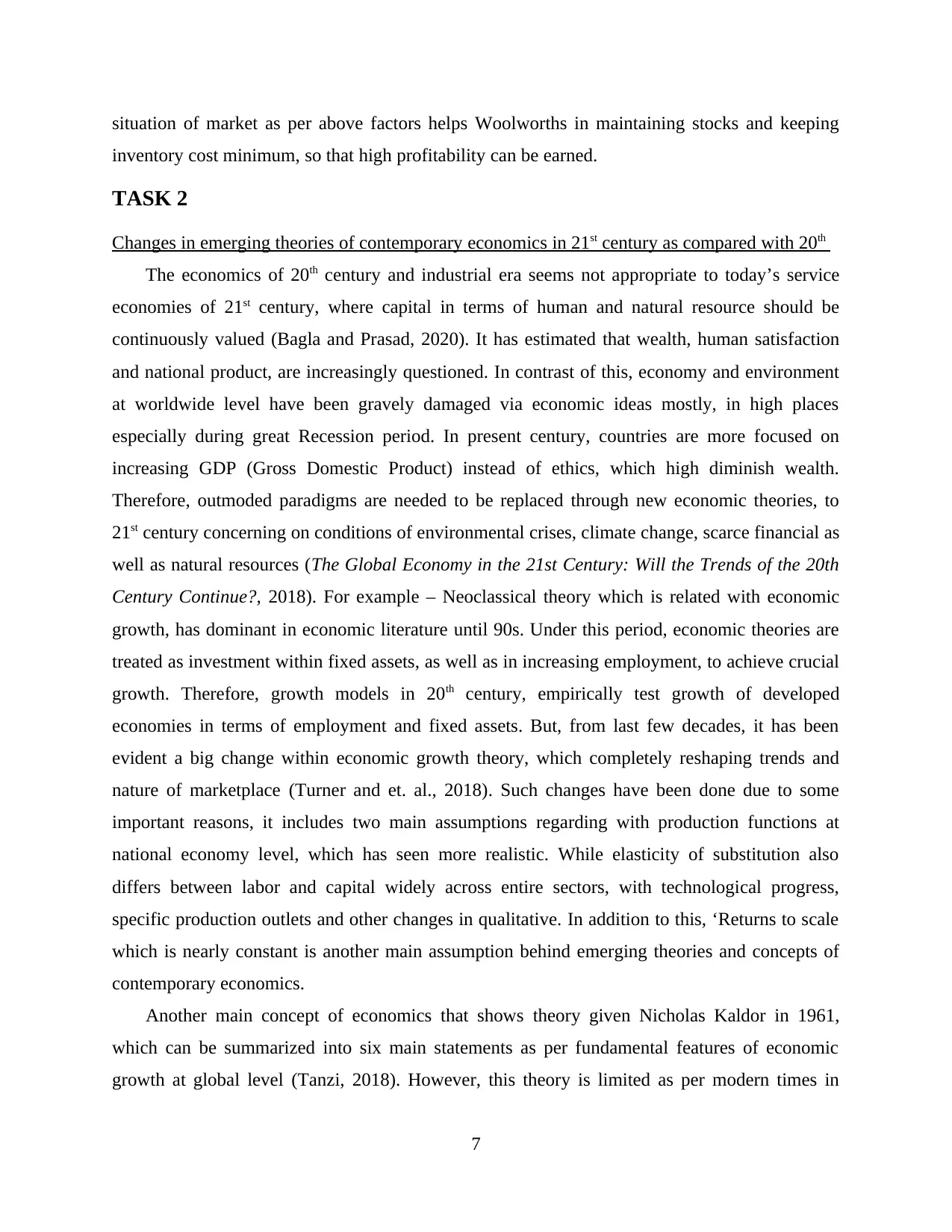
situation of market as per above factors helps Woolworths in maintaining stocks and keeping
inventory cost minimum, so that high profitability can be earned.
TASK 2
Changes in emerging theories of contemporary economics in 21st century as compared with 20th
The economics of 20th century and industrial era seems not appropriate to today’s service
economies of 21st century, where capital in terms of human and natural resource should be
continuously valued (Bagla and Prasad, 2020). It has estimated that wealth, human satisfaction
and national product, are increasingly questioned. In contrast of this, economy and environment
at worldwide level have been gravely damaged via economic ideas mostly, in high places
especially during great Recession period. In present century, countries are more focused on
increasing GDP (Gross Domestic Product) instead of ethics, which high diminish wealth.
Therefore, outmoded paradigms are needed to be replaced through new economic theories, to
21st century concerning on conditions of environmental crises, climate change, scarce financial as
well as natural resources (The Global Economy in the 21st Century: Will the Trends of the 20th
Century Continue?, 2018). For example – Neoclassical theory which is related with economic
growth, has dominant in economic literature until 90s. Under this period, economic theories are
treated as investment within fixed assets, as well as in increasing employment, to achieve crucial
growth. Therefore, growth models in 20th century, empirically test growth of developed
economies in terms of employment and fixed assets. But, from last few decades, it has been
evident a big change within economic growth theory, which completely reshaping trends and
nature of marketplace (Turner and et. al., 2018). Such changes have been done due to some
important reasons, it includes two main assumptions regarding with production functions at
national economy level, which has seen more realistic. While elasticity of substitution also
differs between labor and capital widely across entire sectors, with technological progress,
specific production outlets and other changes in qualitative. In addition to this, ‘Returns to scale
which is nearly constant is another main assumption behind emerging theories and concepts of
contemporary economics.
Another main concept of economics that shows theory given Nicholas Kaldor in 1961,
which can be summarized into six main statements as per fundamental features of economic
growth at global level (Tanzi, 2018). However, this theory is limited as per modern times in
7
inventory cost minimum, so that high profitability can be earned.
TASK 2
Changes in emerging theories of contemporary economics in 21st century as compared with 20th
The economics of 20th century and industrial era seems not appropriate to today’s service
economies of 21st century, where capital in terms of human and natural resource should be
continuously valued (Bagla and Prasad, 2020). It has estimated that wealth, human satisfaction
and national product, are increasingly questioned. In contrast of this, economy and environment
at worldwide level have been gravely damaged via economic ideas mostly, in high places
especially during great Recession period. In present century, countries are more focused on
increasing GDP (Gross Domestic Product) instead of ethics, which high diminish wealth.
Therefore, outmoded paradigms are needed to be replaced through new economic theories, to
21st century concerning on conditions of environmental crises, climate change, scarce financial as
well as natural resources (The Global Economy in the 21st Century: Will the Trends of the 20th
Century Continue?, 2018). For example – Neoclassical theory which is related with economic
growth, has dominant in economic literature until 90s. Under this period, economic theories are
treated as investment within fixed assets, as well as in increasing employment, to achieve crucial
growth. Therefore, growth models in 20th century, empirically test growth of developed
economies in terms of employment and fixed assets. But, from last few decades, it has been
evident a big change within economic growth theory, which completely reshaping trends and
nature of marketplace (Turner and et. al., 2018). Such changes have been done due to some
important reasons, it includes two main assumptions regarding with production functions at
national economy level, which has seen more realistic. While elasticity of substitution also
differs between labor and capital widely across entire sectors, with technological progress,
specific production outlets and other changes in qualitative. In addition to this, ‘Returns to scale
which is nearly constant is another main assumption behind emerging theories and concepts of
contemporary economics.
Another main concept of economics that shows theory given Nicholas Kaldor in 1961,
which can be summarized into six main statements as per fundamental features of economic
growth at global level (Tanzi, 2018). However, this theory is limited as per modern times in
7
Paraphrase This Document
Need a fresh take? Get an instant paraphrase of this document with our AI Paraphraser
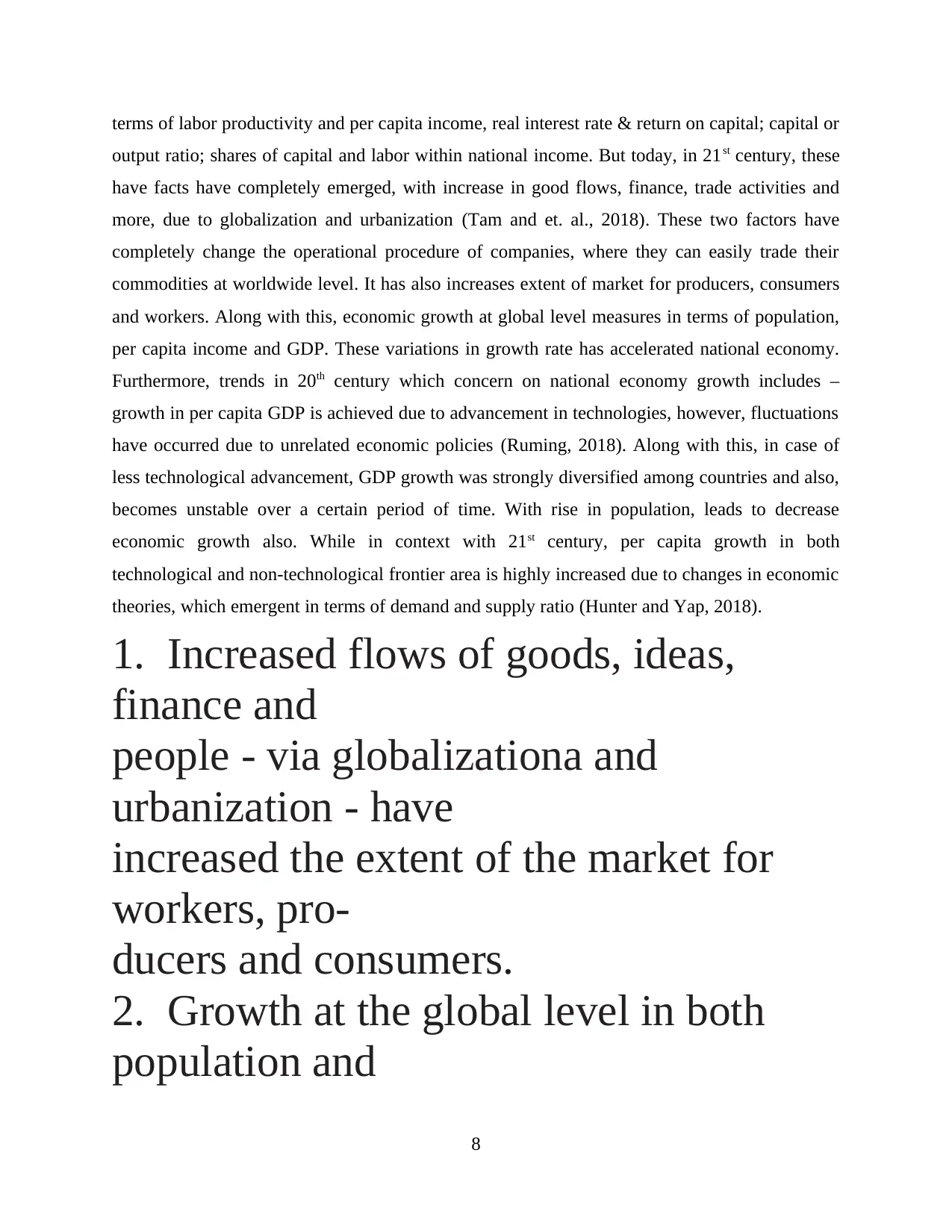
terms of labor productivity and per capita income, real interest rate & return on capital; capital or
output ratio; shares of capital and labor within national income. But today, in 21st century, these
have facts have completely emerged, with increase in good flows, finance, trade activities and
more, due to globalization and urbanization (Tam and et. al., 2018). These two factors have
completely change the operational procedure of companies, where they can easily trade their
commodities at worldwide level. It has also increases extent of market for producers, consumers
and workers. Along with this, economic growth at global level measures in terms of population,
per capita income and GDP. These variations in growth rate has accelerated national economy.
Furthermore, trends in 20th century which concern on national economy growth includes –
growth in per capita GDP is achieved due to advancement in technologies, however, fluctuations
have occurred due to unrelated economic policies (Ruming, 2018). Along with this, in case of
less technological advancement, GDP growth was strongly diversified among countries and also,
becomes unstable over a certain period of time. With rise in population, leads to decrease
economic growth also. While in context with 21st century, per capita growth in both
technological and non-technological frontier area is highly increased due to changes in economic
theories, which emergent in terms of demand and supply ratio (Hunter and Yap, 2018).
1. Increased flows of goods, ideas,
finance and
people - via globalizationa and
urbanization - have
increased the extent of the market for
workers, pro-
ducers and consumers.
2. Growth at the global level in both
population and
8
output ratio; shares of capital and labor within national income. But today, in 21st century, these
have facts have completely emerged, with increase in good flows, finance, trade activities and
more, due to globalization and urbanization (Tam and et. al., 2018). These two factors have
completely change the operational procedure of companies, where they can easily trade their
commodities at worldwide level. It has also increases extent of market for producers, consumers
and workers. Along with this, economic growth at global level measures in terms of population,
per capita income and GDP. These variations in growth rate has accelerated national economy.
Furthermore, trends in 20th century which concern on national economy growth includes –
growth in per capita GDP is achieved due to advancement in technologies, however, fluctuations
have occurred due to unrelated economic policies (Ruming, 2018). Along with this, in case of
less technological advancement, GDP growth was strongly diversified among countries and also,
becomes unstable over a certain period of time. With rise in population, leads to decrease
economic growth also. While in context with 21st century, per capita growth in both
technological and non-technological frontier area is highly increased due to changes in economic
theories, which emergent in terms of demand and supply ratio (Hunter and Yap, 2018).
1. Increased flows of goods, ideas,
finance and
people - via globalizationa and
urbanization - have
increased the extent of the market for
workers, pro-
ducers and consumers.
2. Growth at the global level in both
population and
8
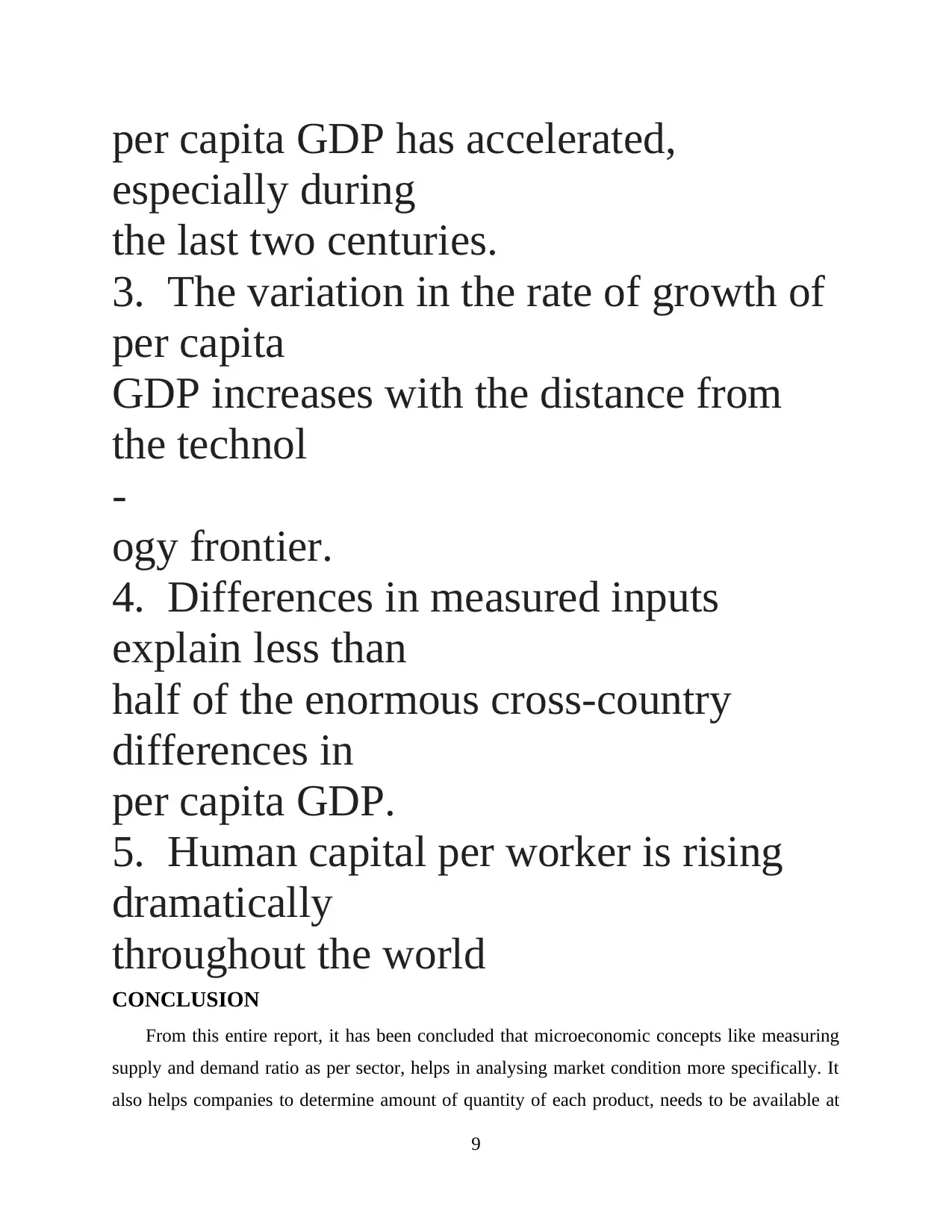
per capita GDP has accelerated,
especially during
the last two centuries.
3. The variation in the rate of growth of
per capita
GDP increases with the distance from
the technol
-
ogy frontier.
4. Differences in measured inputs
explain less than
half of the enormous cross-country
differences in
per capita GDP.
5. Human capital per worker is rising
dramatically
throughout the world
CONCLUSION
From this entire report, it has been concluded that microeconomic concepts like measuring
supply and demand ratio as per sector, helps in analysing market condition more specifically. It
also helps companies to determine amount of quantity of each product, needs to be available at
9
especially during
the last two centuries.
3. The variation in the rate of growth of
per capita
GDP increases with the distance from
the technol
-
ogy frontier.
4. Differences in measured inputs
explain less than
half of the enormous cross-country
differences in
per capita GDP.
5. Human capital per worker is rising
dramatically
throughout the world
CONCLUSION
From this entire report, it has been concluded that microeconomic concepts like measuring
supply and demand ratio as per sector, helps in analysing market condition more specifically. It
also helps companies to determine amount of quantity of each product, needs to be available at
9
⊘ This is a preview!⊘
Do you want full access?
Subscribe today to unlock all pages.

Trusted by 1+ million students worldwide
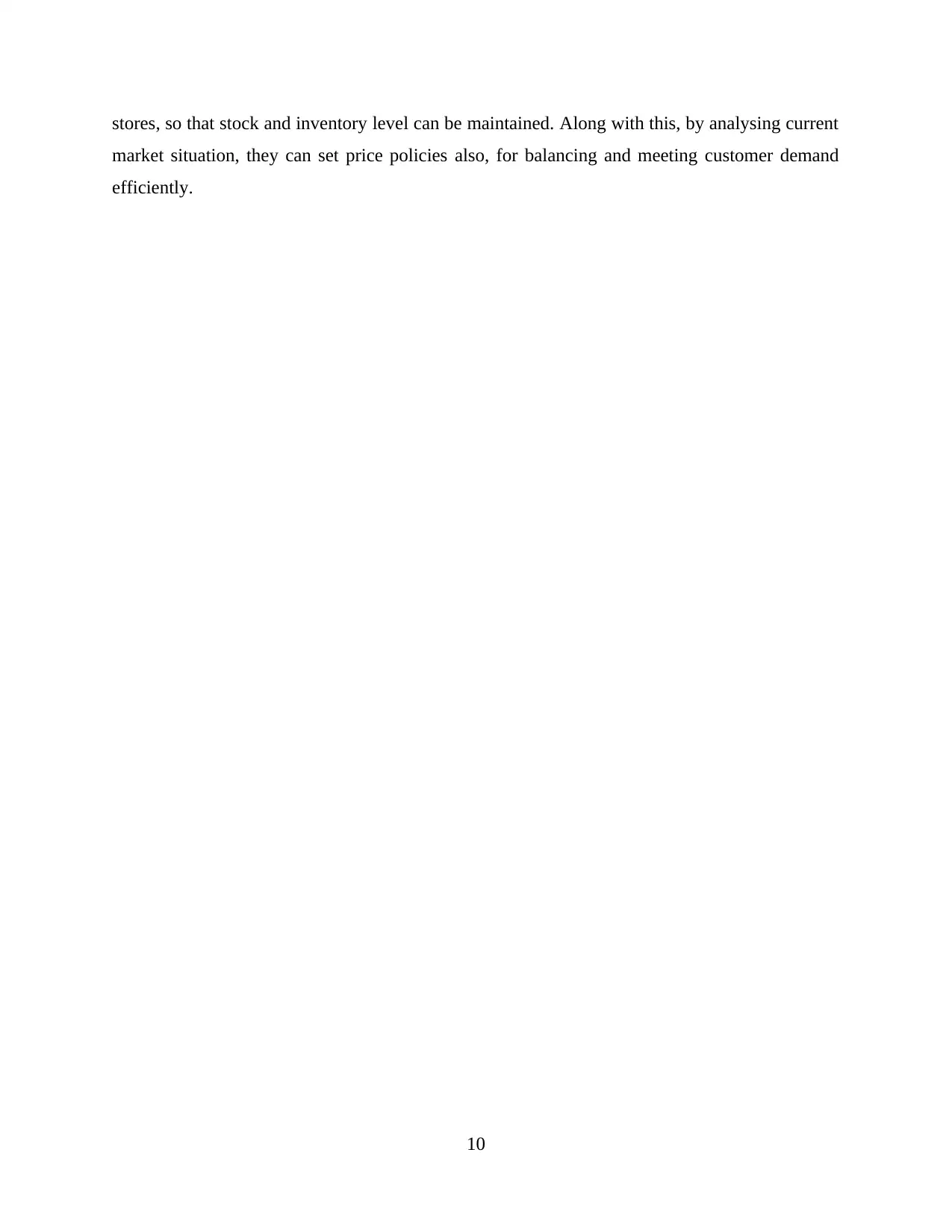
stores, so that stock and inventory level can be maintained. Along with this, by analysing current
market situation, they can set price policies also, for balancing and meeting customer demand
efficiently.
10
market situation, they can set price policies also, for balancing and meeting customer demand
efficiently.
10
Paraphrase This Document
Need a fresh take? Get an instant paraphrase of this document with our AI Paraphraser
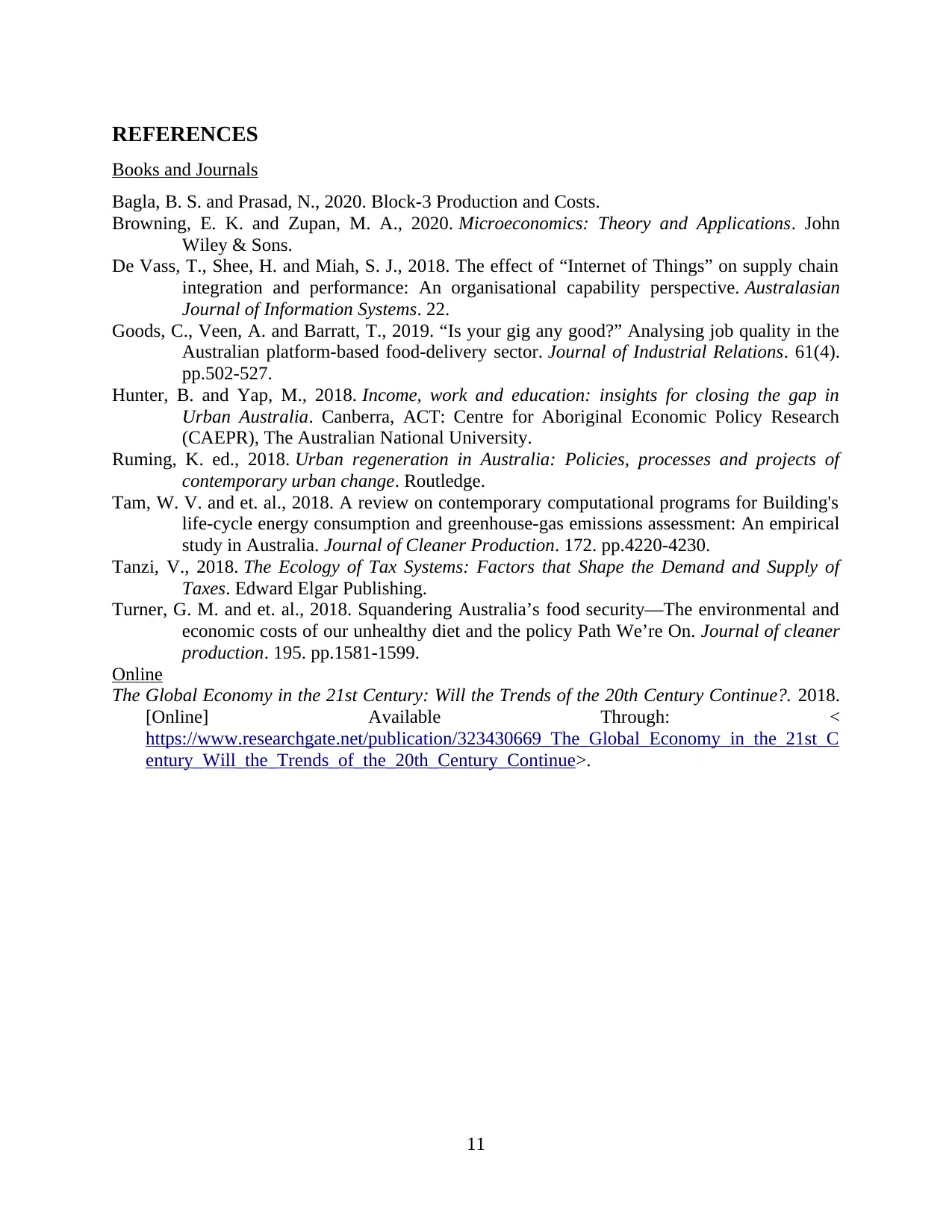
REFERENCES
Books and Journals
Bagla, B. S. and Prasad, N., 2020. Block-3 Production and Costs.
Browning, E. K. and Zupan, M. A., 2020. Microeconomics: Theory and Applications. John
Wiley & Sons.
De Vass, T., Shee, H. and Miah, S. J., 2018. The effect of “Internet of Things” on supply chain
integration and performance: An organisational capability perspective. Australasian
Journal of Information Systems. 22.
Goods, C., Veen, A. and Barratt, T., 2019. “Is your gig any good?” Analysing job quality in the
Australian platform-based food-delivery sector. Journal of Industrial Relations. 61(4).
pp.502-527.
Hunter, B. and Yap, M., 2018. Income, work and education: insights for closing the gap in
Urban Australia. Canberra, ACT: Centre for Aboriginal Economic Policy Research
(CAEPR), The Australian National University.
Ruming, K. ed., 2018. Urban regeneration in Australia: Policies, processes and projects of
contemporary urban change. Routledge.
Tam, W. V. and et. al., 2018. A review on contemporary computational programs for Building's
life-cycle energy consumption and greenhouse-gas emissions assessment: An empirical
study in Australia. Journal of Cleaner Production. 172. pp.4220-4230.
Tanzi, V., 2018. The Ecology of Tax Systems: Factors that Shape the Demand and Supply of
Taxes. Edward Elgar Publishing.
Turner, G. M. and et. al., 2018. Squandering Australia’s food security—The environmental and
economic costs of our unhealthy diet and the policy Path We’re On. Journal of cleaner
production. 195. pp.1581-1599.
Online
The Global Economy in the 21st Century: Will the Trends of the 20th Century Continue?. 2018.
[Online] Available Through: <
https://www.researchgate.net/publication/323430669_The_Global_Economy_in_the_21st_C
entury_Will_the_Trends_of_the_20th_Century_Continue>.
11
Books and Journals
Bagla, B. S. and Prasad, N., 2020. Block-3 Production and Costs.
Browning, E. K. and Zupan, M. A., 2020. Microeconomics: Theory and Applications. John
Wiley & Sons.
De Vass, T., Shee, H. and Miah, S. J., 2018. The effect of “Internet of Things” on supply chain
integration and performance: An organisational capability perspective. Australasian
Journal of Information Systems. 22.
Goods, C., Veen, A. and Barratt, T., 2019. “Is your gig any good?” Analysing job quality in the
Australian platform-based food-delivery sector. Journal of Industrial Relations. 61(4).
pp.502-527.
Hunter, B. and Yap, M., 2018. Income, work and education: insights for closing the gap in
Urban Australia. Canberra, ACT: Centre for Aboriginal Economic Policy Research
(CAEPR), The Australian National University.
Ruming, K. ed., 2018. Urban regeneration in Australia: Policies, processes and projects of
contemporary urban change. Routledge.
Tam, W. V. and et. al., 2018. A review on contemporary computational programs for Building's
life-cycle energy consumption and greenhouse-gas emissions assessment: An empirical
study in Australia. Journal of Cleaner Production. 172. pp.4220-4230.
Tanzi, V., 2018. The Ecology of Tax Systems: Factors that Shape the Demand and Supply of
Taxes. Edward Elgar Publishing.
Turner, G. M. and et. al., 2018. Squandering Australia’s food security—The environmental and
economic costs of our unhealthy diet and the policy Path We’re On. Journal of cleaner
production. 195. pp.1581-1599.
Online
The Global Economy in the 21st Century: Will the Trends of the 20th Century Continue?. 2018.
[Online] Available Through: <
https://www.researchgate.net/publication/323430669_The_Global_Economy_in_the_21st_C
entury_Will_the_Trends_of_the_20th_Century_Continue>.
11
1 out of 14
Related Documents
Your All-in-One AI-Powered Toolkit for Academic Success.
+13062052269
info@desklib.com
Available 24*7 on WhatsApp / Email
![[object Object]](/_next/static/media/star-bottom.7253800d.svg)
Unlock your academic potential
© 2024 | Zucol Services PVT LTD | All rights reserved.





